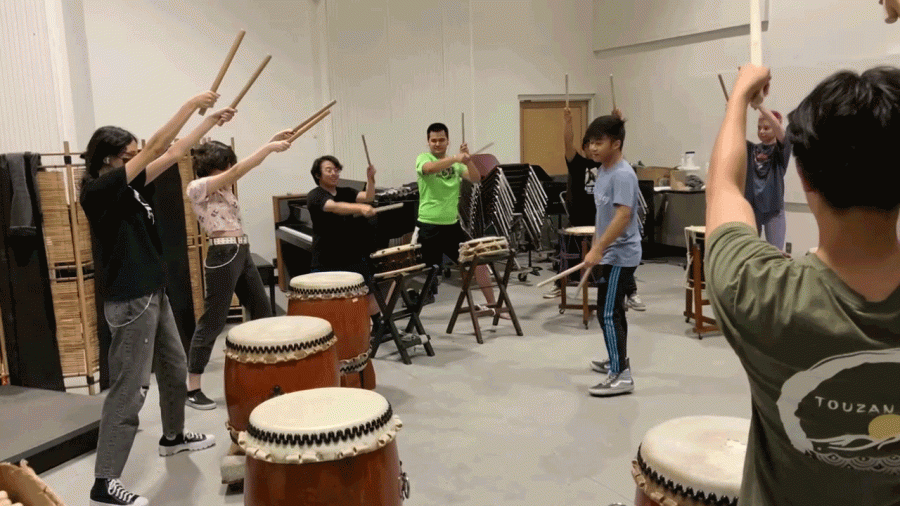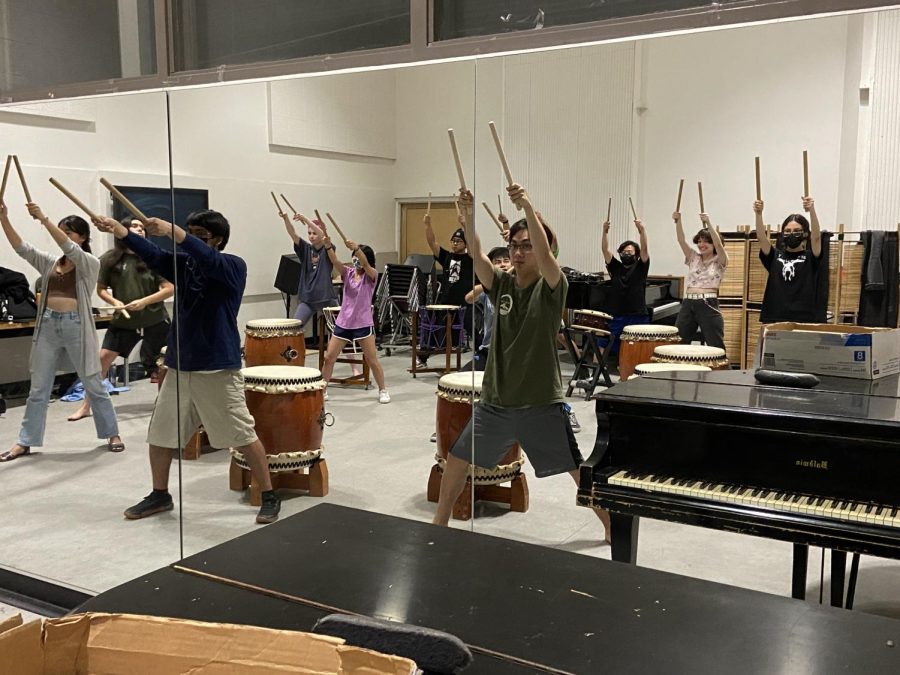Jishin Taiko sounds the drums at CSUN
Jishin Taiko Ensemble members learn proper stance from co-directors Kyle Dang and Shaun Riel on Sept. 26, 2022, in Northridge, Calif.
November 22, 2022
This story is a multimedia piece that incorporates audio and text. To experience the full story, click the play button on the audio players underneath each section.
What started as sporadic and random noise coming from room 106 in Nordhoff Hall at CSUN’s campus on Sept. 26 slowly transformed into concise rhythmic drum beats. This is the sound of the Japanese drumming club Jishin Taiko Ensemble in their second weekly practice since gaining new members.
Jishin Taiko is a CSUN club that was formed after the 1994 Northridge earthquake, and has grown over the years as an ensemble that spreads the love of music and culture through traditional Japanese drumming.
The name originates from the Japanese phrase “jishin,” meaning earthquake or self-confidence, and “taiko,” a broad range of Japanese percussion instruments. The club began in 1995 under the Nikkei Student Association, later branching away and renaming itself Jishin Taiko in 2002.
According to the club’s website, it is “one of the oldest collegiate taiko ensemble established in North America” — with UCLA’s Kyodo Taiko being the oldest, having been founded in 1990. During the Civil Rights movement, Japanese Americans who felt displaced in their homes used taiko to reconnect back to their heritage.
Shaun Riel and Kyle Dang, the two directors of the club, teach its members not only how to play the instruments, but also the differences between each drum and the importance that each movement has when performing.

“Taiko isn’t just banging the drums, just making music — because it’s also very visual,” said Riel. “It’s a lot of arm movements, and it’s a lot of stage presentation. Actually, the music is very simple, but the appeal of it really comes with how you look while playing onstage.”
“Taiko has been a way to literally create noise for Asian American outreach,” said Riel. The ensemble often performs at events around CSUN and the surrounding area, while celebrating the culture of Asian Americans and Pacific Islanders. The group’s most recent performance was on June 30 at CSUN’s “Summer Movie Fest,” before a showing of “Shang-Chi and the Legend of the Ten Rings.”
The club starts off each member on the chu-daiko, which is a smaller version of the daiko. These drums are what make up the majority of an ensemble. On these drums they are taught the basics, such as a five-step method of how to hit the daiko with their “bachi,” meaning drumsticks.
The returning members can take on the shime-daiko, which are primarily used by the club as a cadence marker.
“We had them leading the exercise earlier because they are the most high-pitched ones, and they’re the ones that everyone should be listening to, [in order to] stay in time with the whole ensemble,” said Riel.
Jin Taguchi, a CSUN alumni and returner to the club, is one of two members who use the shime-daiko. Taguchi, who graduated in the spring of 2022 with a bachelor’s degree in music education, found out about the club while studying women in taiko for his global music class.
“I love music, first of all,” said Taguchi, who still regularly attends meetings. “This is a great way to get in touch with a group run by students, and so passionately run by students.”
On top of their performances around the CSUN area, the ensemble also travels to Torrance to compete at AniFest, an annual one-day anime festival that highlights Japanese culture. Jishin Taiko goes against three other collegiate taiko groups from Cal Poly Pomona, the University of California, Riverside and the University of California, Irvine.
Despite many of the club’s members having no musical experience before joining, the co-directors are preparing them for competing.
“We don’t have too many members, but we want all of them to play,” said Riel. “We always want them to play and get out there, and have that competitive type of experience.”


